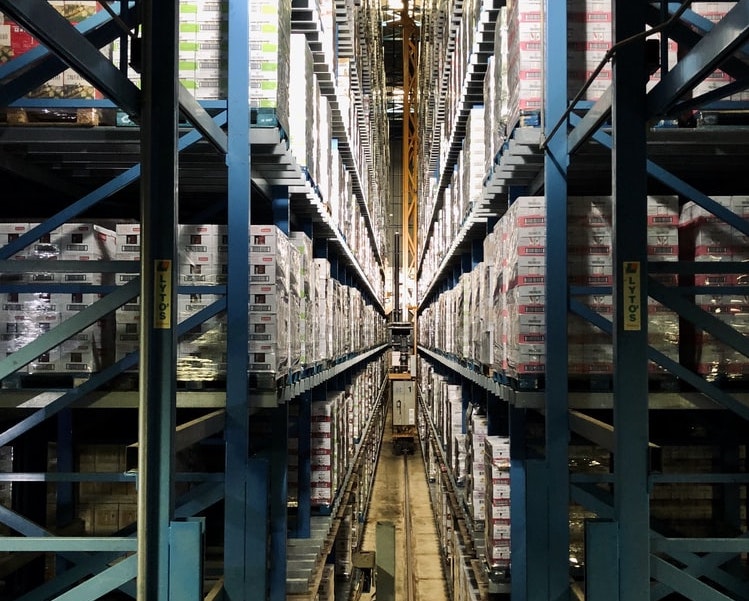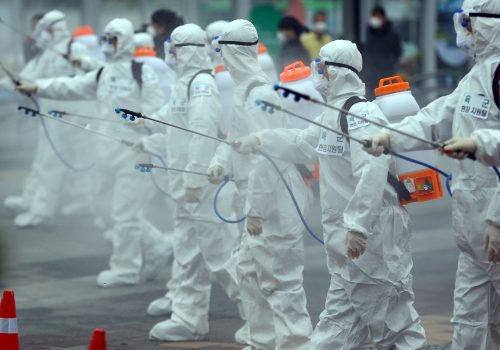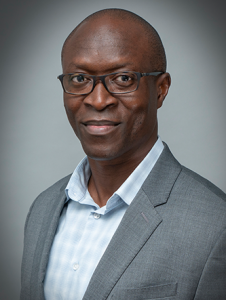What world post COVID-19?: A conversation with Dr. Conrad Tucker
This interview is part of a series conducted by the Atlantic Council’s Foresight, Strategy, and Risks initiative on the potential impacts of COVID-19. The interviews feature insights from the FSR initiative’s Nonresident Senior Fellows, a set of experts drawn from across a wide range of fields. In this interview, Dr. Conrad Tucker, professor of mechanical engineering at Carnegie Mellon University, explains how the pandemic is changing conversations around the value of higher education, the relation of technology and labor, and the applications of machine learning.
How is COVID-19 reshaping the higher education landscape?
I think COVID-19 has highlighted the value of in-person interaction. What is it about a physical classroom experience that makes it conducive to engagement and can that same engagement be achieved in a virtual platform? Those still are open questions. While academics have pondered these questions for some time, COVID-19 has accelerated the need for them to be answered. Perhaps these differences are due to our own human biases. If we were all born into a world of just video conferences and virtual interactions, would in-person interactions feel out of place?
But today, there are many students who still emphasize their desire to be physically on campus, because that’s where they see the value of learning and interaction. From a policy or academic point of view, the balance now becomes, how much risk are organizations or research labs willing to take to have students physically on campus?

What is the interaction between COVID-19 and the curve of technological change?
People are starting to rethink the impact of automation in our society. For many labor-intensive jobs, if they were augmented by robots, would that have helped keep the economy going? Because of COVID-19, will we see more investments in deployments of robotic systems (due to robots’ inability to catch these biological pathogens)? On the flip side, robots and digital systems are also susceptible to cyber “viruses.” Would we be replacing one set of viruses with another?
On this relationship between technological change and human labor, what does the conversation at Carnegie Mellon University (CMU) look like right now?
It’s actually very interesting what we’re seeing from a research perspective because there typically are two camps of researchers. There are the experimentalists and there are theorists/computational researchers. On the computational side of things, our research hasn’t been as negatively impacted because we work on algorithms and data. However, for people who do experimental work in the lab, there may be the extra burden of exploring ways to advance their experimental research work, while simultaneously mitigating the risk exposure to COVID-19. For some colleagues, significant portions of their research operations had to be adjusted to account for COVID-19-related physical distance restrictions.
When you map that to society as a whole, I wonder how organizations will rethink where they make strategic investments. If I’m an automotive manufacturer, am I going to invest more in physical value-added products? Or is it going to be more in the digital landscape, which may be less affected by the next pandemic? That is just one of many possible examples. But it is the kind of conversation that researchers at least are having.

What do you think the impact of all this will be on CMU?
As much as I’m part of the academic system, I have for several years questioned whether or not this business model is sustainable. The university is surrounded by digital innovations and publicly available knowledge. For example, there is well-known, highly cited, high-quality lecture content on YouTube. It’s not uncommon for students currently in physical spaces to supplement their knowledge using these publicly available repositories. Sometimes they even start there and use the classroom experience to supplement what they’ve learned or maybe even just to ask follow up questions.
I’ve been doing some research on digital immersive technologies. Now, you can capture an entire physical 3D space using scanning technologies. This translates to having a three-dimensional virtual environment that could potentially be utilized to perform activities that one would normally do if you were in a physical setting. Can we add value beyond just a virtual video call so that students have enhanced interaction with learning content and their peers?
I have a former graduate student who is working on real-time translation of what his physical hands are doing and mapping that onto the virtual space. One question is if he were to do a scientific study to see what the learning outcomes are for this type of setup versus the classroom physical setup, are there learning differences? This is an active area of research in the education domain. The point is such technologies exist today, and the long-term question is can we combine these technologies in ways that are comparable to physical settings that we currently have?
In terms of collaboration with peers, we’re still looking at a reality where engagements and interactions have either been postponed or just not possible at all. Despite the promise of virtual and augmented reality, it is difficult for me to replicate flying to the CMU Africa campus in Rwanda and meeting with a group of students in their physical space and learning about the culture there. Those kinds of collaborations are very difficult to replicate in a virtual setting. Over the long run, we may live in a world where it’s a hybrid of these technologies mixed with physical interaction.
So, for you, the classic formulation of the university will remain, but it’s going to have to adapt and embrace hybridity?
Yes, and I think we may see a consolidation. There are several institutions that have been well ahead of the curve when it comes to online content and creation, the question then becomes do you need ten videos of Newton’s law to be able to learn that content? Or do you just need the best version?
We may see a consolidation of these different online efforts, but in terms of the physical brick and mortar campus, I think there’s a lot of soul searching and questions.
What we’ve seen over the past several years is sometimes a reductionist idea of education, where higher education is defined as being just a grade point average (GPA) and a degree. We are in this predicament about the university and its purpose because we do not acknowledge that the college experience is so much more than just being in a classroom.
My hope is that universities see this as an opportunity to expand the scope of how they define their mission. Higher education is analogous to a controlled experiment environment, where young adults are able to learn, collaborate, and mature as individuals in society, where they can grow but also fail—and of course learn from their failures.
Sign up for the FSR Newsletter!
Sign up for the Foresight, Strategy and Risks newsletter to remain up to date with our events, publications, and much more! Learn about global risks, technology, emerging security issues, and geopolitics, and discover how current events fit into long-term trends.
How do universities continue to brand, market, and validate the central purpose and experience of higher education?
My hope is this pandemic results in universities revaluating their branding message to students, parents and society as a whole. Because if it just boils down to “here’s a grade, here’s a job” messaging, then universities are in a reductionist trap. They may be the architects of their own demise.
My most memorable experiences in college were outside of the classroom and included projects that connected classroom theory to real world applications, participating in campus clubs, etc. I think that strengthens and highlights the fact that the world is so diverse, that ideas and thoughts on a campus arise from many different places. I think that is really what needs to be emphasized at the university.
Do you have any pointers for how we should be thinking about machine learning and robotics in responding to the pandemic?
Yes. One of the areas that we’ve seen is about data ownership and privacy. Several technology companies have partnered to develop contact tracing technology to combat the spread of COVID-19. That’s great, and contact tracing definitely has the potential to help to contain hotspots. But when you start thinking about how such data can be potentially misused by organizations or entities, it opens many different policy questions.
Recently, there was a technology research group that developed a wearable thermal camera system. It’s like you’re wearing a hat or glasses and as you walk down the street, you can look at each person’s temperature. That may help determine if someone has elevated temperature that correlates to COVID-19. But it also could open the door to discrimination or privacy issues.
So, as a society, we need to make sure that we continue to have the conversation about who owns data, who has access to data, and how we can put policies in place that don’t result in exploitation.

